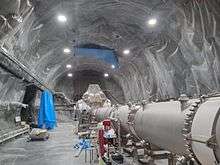KAGRA
 | |
| Organisation | Institute for Cosmic Ray Research |
|---|---|
| Location(s) | Kamioka Observatory, Gifu, Japan |
| Coordinates | 36°24′43″N 137°18′21″E / 36.41194°N 137.30583°E[1]Coordinates: 36°24′43″N 137°18′21″E / 36.41194°N 137.30583°E[1] |
| Altitude | 414 m[1] |
| Telescope style | gravitational-wave detector |
| Diameter | 3,000 m (9,842 ft 6 in) |
| Website |
gwcenter |
The Kamioka Gravitational Wave Detector (KAGRA), formerly the Large Scale Cryogenic Gravitational Wave Telescope (LCGT), is a project of the gravitational wave studies group at the Institute for Cosmic Ray Research (ICRR) of the University of Tokyo. The ICRR was established in 1976 for cosmic ray studies, The LCGT project was approved on 22 June 2010. In January 2012, it was given its new name, KAGRA, deriving the "KA" from its location at the Kamioka mine and "GRA" from gravity and gravitational radiation.[2]
Two prototype detectors have been constructed to develop technologies needed for KAGRA. The first, TAMA 300, was located in Mitaka, Tokyo and operated through 2008, demonstrating the feasibility of KAGRA. The second, CLIO, is operating underground near the KAGRA site, and is being used to develop cryogenic technologies for KAGRA.
KAGRA has two arms, 3 km (1.9 mi) long, which form a laser interferometric gravitational wave detector. It is built in the Kamioka Observatory near the neutrino physics experiments. The excavation phase of tunnels was completed on 31 March 2014.
KAGRA will detect chirp waves from binary neutron star coalescence at 240 Mpc away with a signal to noise ratio of 10. The expected number of detectable events in a year is two or three. To achieve the required sensitivity, the existing state of the art techniques as used by LIGO and VIRGO (low-frequency vibration-isolation system, high-power laser system, Fabry-Pérot cavities, resonant side band extraction method, and so on) will be extended with an underground location, cryogenic mirrors, and a suspension point interferometer.
KAGRA has suffered numerous delays. Early planning had hoped to begin construction in 2005 and observation in 2009[3] but is now likely to enter operation in 2018.[4] Excess water in the tunnels caused significant delays in 2014 and 2015.[5][6]
Initial operation ("iKAGRA") with room-temperature test masses was hoped to begin in December 2015.[5][7][8] The "baseline" planned cryogenic operation ("bKAGRA") will follow a few years later.
See also
- TAMA300, an early prototype in Japan.
- CLIO, a current prototype that is developing cryogenic technologies.
- DECIGO, a proposed Japanese space-based interferometer.
References
- 1 2 3 Yoshio Saito (11 Jul 2015). KAGRA location (pptx) (Report). KAGRA Collaboration. JGW-G1503824-v1.
- ↑ "LCGT got new nickname "KAGRA"".
- ↑ Uchiyama, T.; et al. (2004). "Present status of large-scale cryogenic gravitational wave telescope" (PDF). Class. Quantum Grav. 21 (5): S1161–S1172. Bibcode:2004CQGra..21S1161U. doi:10.1088/0264-9381/21/5/115.
We hope that the beginning of the project will be in 2005 and the observations will start in 2009.
- ↑ Kuroda, K.; et al. (April 2010). "Status of LCGT" (PDF). Class. Quantum Grav. 27 (8): 084004. Bibcode:2010CQGra..27h4004K. doi:10.1088/0264-9381/27/8/084004.
- 1 2 Kajita, Takaaki (17 June 2015). Status of the KAGRA Project (PDF). Gravitational Wave Physics and Astronomy Workshop 2015. Osaka.
- ↑ Miyoki, Sinji (2 February 2016). Underground and Cryogenic Lessons in KAGRA. 7th Einstein Telescope Symposium. Firenze.
- ↑ Kanda, Nobuyuki (13 July 2015). Status of KAGRA: construction, commissioning and data distribution toward the first operation in 2015 (PDF). Fourteenth Marcel Grossmann Meeting (MG14). Rome.
- ↑ "KAGRA's Initial Operation To Begin Soon" (Press release). Institute for Cosmic Ray Research. 6 November 2015.

